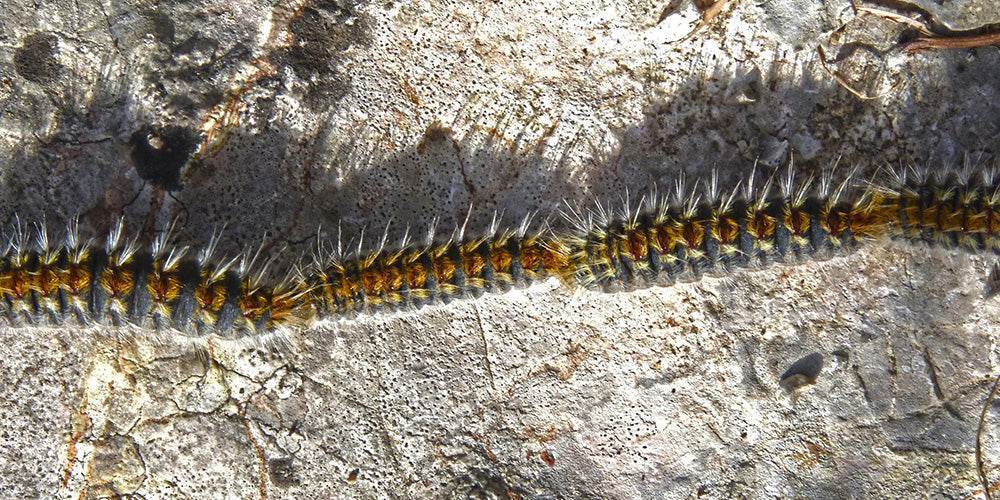
What to Do If Your Dog Comes into Contact with Caterpillars? A Guide to Acting Quickly and Avoiding Problems
Imagine you're taking a leisurely walk with your dog through the woods or park, and suddenly, your furry friend comes into contact with a caterpillar! What would you do? Sometimes, these tiny insects can cause serious problems, especially processionary caterpillars, which are very dangerous for dogs.
In this article, we'll tell you everything you need to know about what to do if your dog comes into contact with caterpillars, how to detect an allergic reaction, and which caterpillars are toxic to them.
Why should you keep reading?
This article isn't just for dog lovers, but for anyone who wants to know how to protect their furry friends from risks that, although small, can be very serious. Here, we'll explain how to react if your dog comes into contact with caterpillars and, most importantly, how to prevent this from causing serious health problems. So keep reading—we promise you'll learn something that could save your dog's life!
What Are Caterpillars and Why Are They Dangerous for Dogs?
Caterpillars are the larval stage of certain insects, such as butterflies, and some of them are extremely dangerous for dogs. Although all caterpillars have fine hairs on their bodies, some species, such as the processionary caterpillar, have stinging hairs that can cause severe allergic reactions. If your dog comes into contact with them, they can irritate their skin and eyes, and in some cases, even affect their digestive or respiratory systems.
Why should you be careful with caterpillars?
Some caterpillars, especially processionary caterpillars, have poisonous hairs that can be dangerous to dogs. If a dog touches or licks these hairs, they can suffer from simple skin irritation to much more serious problems, such as difficulty breathing or tissue damage in the mouth and tongue.
What to Do If Your Dog Touches a Caterpillar?
The first thing you should know is that acting quickly is key. If your dog comes into contact with a caterpillar, follow these steps:
1. Stay calm Even if it may be alarmingIt's very important to stay calm. If you're nervous, your dog will notice and become more anxious, which can make things worse.
2. Check the dog quickly. If your dog has touched or bitten a caterpillar, check its body and mouth for signs of irritation. The most commonly affected areas are the face, tongue, and paws. If you notice any bumps, swelling, or redness, your dog may have had an allergic reaction to the caterpillar's hairs.
3. Wash your hands before touching your dog. It's important that you also take precautions. Wash your hands thoroughly to prevent the stinging hairs from spreading to other parts of your body or to your dog if you touch him.
4. Seek urgent veterinary attention. If you notice any signs of poisoning or a severe allergic reaction (such as facial swelling, difficulty breathing, vomiting, or diarrhea), take your dog to the vet immediately. The speed with which you act can make all the difference.
How to Identify an Allergic Reaction in Your Dog?
When your dog comes into contact with a caterpillar, an allergic reaction may occur. Reactions can vary depending on the number of stinging hairs the dog has touched and its sensitivity.
Common Allergic Reaction Symptoms • Swelling of the face, lips, or tongue
• Tears or eye discharge
• Difficulty breathing or shortness of breath
• Excessive salivation
• Vomiting or diarrhea
• Redness or papules (bumps) on the skin
If you notice any of these symptoms, it's important to consult a veterinarian, as the processionary caterpillar is very dangerous and can cause serious damage.
What Are Processionary Caterpillars and Why Are They So Dangerous?
The processionary caterpillar is one of the most dangerous species for dogs and other animals. It is characterized by its group behavior: the caterpillars march in a single file, as if in a procession, hence its name. These insects are usually found in pine trees, and during certain times of the year, they can be present in large numbers.
What makes the processionary caterpillar dangerous is its stinging hairs, which release a toxin that can be very dangerous to dogs. When caterpillars feel threatened, they release these hairs, which can cause very severe allergic reactions, even in animals that are not allergic.
Where to Find Processionary Caterpillars?
These caterpillars usually live in areas near pine trees, especially during spring and summer. They are commonly seen in parks, forests, and gardens where there are pine trees. However, they can sometimes also be found in urban areas, so it's important to be vigilant.
How to Avoid Contact with Caterpillars?
Avoiding contact with caterpillars is one of the best ways to protect your dog from these dangers. Here are some recommendations to prevent your dog from coming into contact with them:
1. Avoid areas with pine trees during spring and summer. During these months, processionary caterpillars are most active. If you know an area is infested with pine trees, it's best to avoid it to reduce the risk.
2. Keep your dog on a leash. If you're in an area where caterpillars might be present, keep your dog under control at all times. Don't let him explore unsupervised, especially near pine trees.
3. Check your dog after every walk. Once you're done walking, check your dog for any traces of caterpillars or skin irritation. If you notice anything unusual, take your dog to the vet.
What to Do if You Can't Avoid Contact with Processionary Caterpillars?
If for some reason your dog has already had contact with a caterpillar and you couldn't avoid it, the most important thing is to be alert for any symptoms of an allergic reaction and seek veterinary help immediately.
Veterinarians have the knowledge and resources to treat severe allergic reactions. In some cases, medication may be needed to reduce inflammation or to treat poisoning caused by stinging hairs.
Caution is Key
Caterpillars, especially processionary caterpillars, can be dangerous for dogs if they come into contact with them. It's important to act quickly if you suspect your dog has come into contact with a caterpillar. Stay calm, check your dog's body for symptoms, and don't hesitate to contact your veterinarian if you notice anything unusual.
Remember that prevention is the most effective. Avoiding infested areas and keeping your dog under control in areas where caterpillars may be present is essential to reducing the risk.
So now you know! With these tips, you can protect your dog and enjoy your walks without worries.


